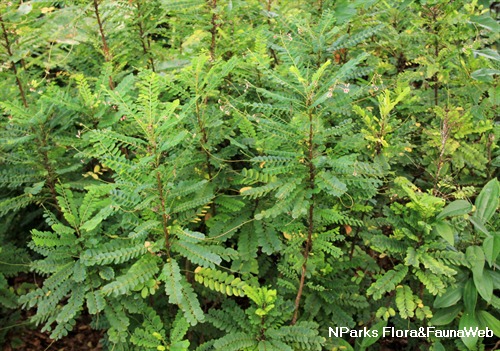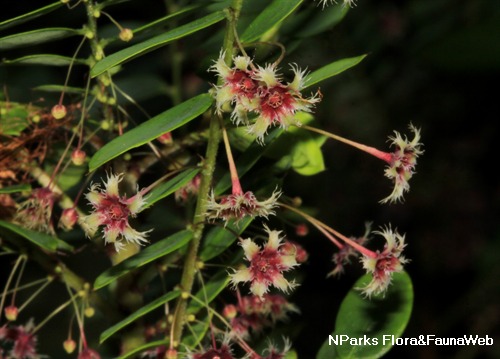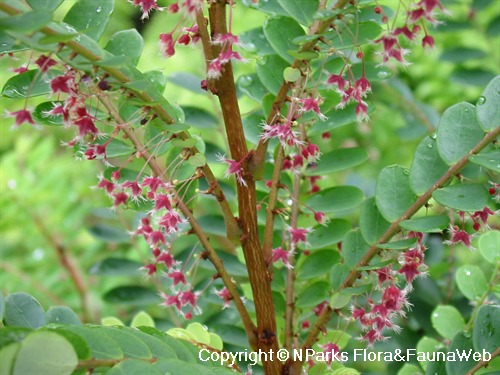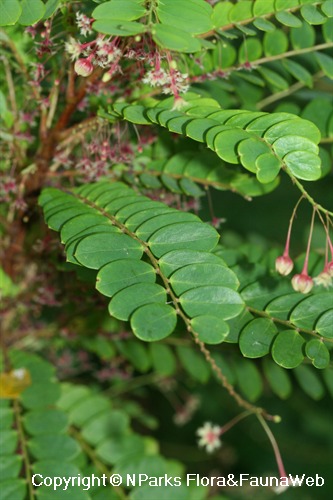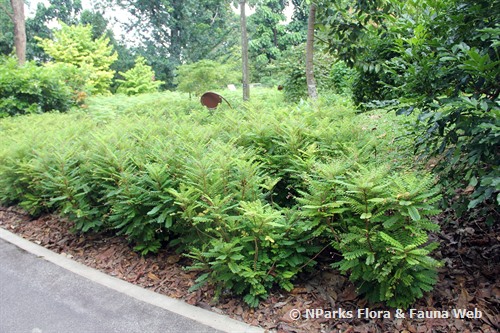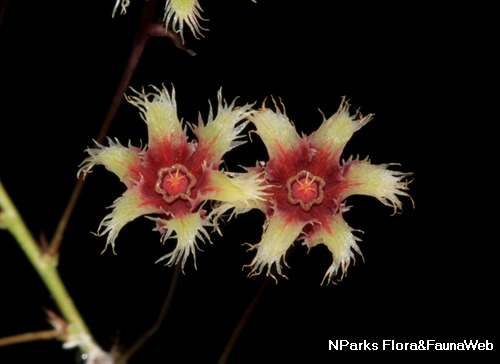
Back
Nymphanthus glaucescens (Miq.) R.W.Bouman
| Family Name: | Phyllanthaceae |
| Synonyms: | Phyllanthus pulcher Wall. ex Müll.Arg. |
Name
Classifications and Characteristics
| Plant Division | Angiosperms (Flowering Seed Plants) (Dicotyledon) |
|---|---|
| Plant Growth Form | Shrub |
| Lifespan (in Singapore) | Perennial |
| Mode of Nutrition | Autotrophic |
| Plant Shape | Shrubby |
Biogeography
| Native Distribution | Thailand, Virgin island, Southern China to Western Malesia |
|---|---|
| Native Habitat | Terrestrial |
| Preferred Climate Zone | Tropical |
| Local Conservation Status | Non-native |
Description and Ethnobotany
| Growth Form | Small-sized shrub, able to grow up to about 1.5 m tall. |
|---|---|
| Foliage | Simple leaf, the shoots bear alternate leaves in flat sprays that imitate pinnate leaves. They are arranged in two vertical rows on opposite of the stem. The plant bear their flowers and fruits in the axils of the small leaves thereby confirming the small leaves are really leaves, not leaflets. Glabrous (smooth, hairless) except for puberulent young branches and bracts. Leaf blade is obliquely oblong to ovate-oblong, measuring up to 3 cm long by 1.3 cm wide, grey-green on the underside while green on the upper side. |
| Flowers | Flowers have hairy bracts that look irregularly torn, dark red in colour. Male flower has soft and delicate pedicel (about 15 - 10 mm long), 4 sepals, dark red; filaments are short and connected. Female flower has hairlike pedicel which is longer than male flower (about 15 - 20 mm long); 6 sepals. |
| Habitat | It is commonly found in open forests and riverside scrub area. |
| Etymology | The specific epithet pulcher means beautiful. |
| Ethnobotanical Uses | Food (Herb or Spice) |
Landscaping Features
| Desirable Plant Features | Ornamental Flowers, Ornamental Foliage |
|---|---|
| Landscape Uses | General, Parks & Gardens, Small Gardens |
Plant Care and Propagation
| Light Preference | Full Sun, Semi-Shade |
|---|---|
| Water Preference | Moderate Water |
| Plant Growth Rate | Moderate |
| Rootzone Tolerance | Well-Drained Soils |
| Propagation Method | Seed |
Foliar
| Foliage Retention | Evergreen |
|---|---|
| Mature Foliage Colour(s) | Green |
| Mature Foliage Texture(s) | Smooth, Glossy / Shiny |
| Foliar Type | Simple / Unifoliate |
| Foliar Arrangement Along Stem | Alternate |
| Foliar Attachment to Stem | Petiolate |
| Foliar Shape(s) | Non-Palm Foliage (Oblong) |
| Foliar Venation | Pinnate / Net |
| Foliar Margin | Entire |
| Foliar Apex - Tip | Apiculate |
| Foliar Base | Acute |
| Leaf Area Index (LAI) for Green Plot Ratio | 4.5 (Shrub & Groundcover - Dicot) |
Floral (Angiosperm)
| Flower & Plant Sexuality | Bisexual Flowers |
| Flower Colour(s) | Pink |
|---|---|
| Flower Grouping | Cluster / Inflorescence |
| Flower Location | Axillary |
| Flowering Period | Free-Flowering |
References
| References | Bouman, R. et al. (2022). A revised phylogenetic classification of tribe Phyllantheae (Phyllanthaceae). Phytotaxa 540(1): 1–100. |
|---|
Image Repository
Others
| Master ID | 1042 |
|---|---|
| Species ID | 5062 |
| Flora Disclaimer | The information in this website has been compiled from reliable sources, such as reference works on medicinal plants. It is not a substitute for medical advice or treatment and NParks does not purport to provide any medical advice. Readers should always consult his/her physician before using or consuming a plant for medicinal purposes. |

